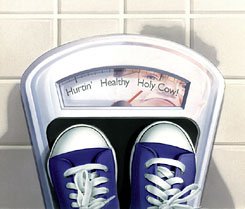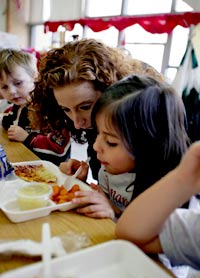Educational Institutions Step into the Ring to Fight for Fitness
Schools battle an epidemic of childhood obesity — a problem they helped create.

The aroma of fast food has long been a temptation for hungry Americans. Yet many of us, scolded by doctors and taunted by our bathroom scales, have begun to resist the guilty pleasure of a greasy burger and fries.
Many of our children, however, are not so lucky. The percentage of overweight children ages 6-19 has nearly quadrupled in the United States since the 1960s, according to the federal Centers for Disease Control and Prevention (CDC). Today, 16 percent of children, or about 9 million kids, are overweight (defined as at or above the 95th percentile of the CDC growth charts for age and sex). Many more are at risk of becoming that way.
Factor in the increasing childhood propensity to spend less time kicking a soccer ball around and more hours in front of a television or computer screen, and you have the recipe for a generation of overweight kids who some health experts predict may actually have shorter life spans than their parents.
With extra heft comes a notorious array of health problems such as high blood pressure, sleep disorders, high cholesterol, asthma, joint problems, and Type II diabetes. An overweight child is more likely than other kids to be overweight as an adult, thus more susceptible to developing potentially fatal chronic diseases, most notably heart disease. "Obesity threatens to reverse the gains we made in the control of diseases such as heart disease and cancer," says the CDC's William Dietz.
Home eating and recreational habits are a big factor in this crisis. Kids look to their parents for lifestyle cues and meal planning. Look around: We've become a nation of droopy-jeaned waddlers.
But kids also spend a large part of their day at school; some have two meals there. What role, then, do schools play in reversing the unhealthy slide?
Readin', 'Ritin', and Root Beer
At first whiff, schools seem to contribute to the obesity problem. Struggling to save money, school districts favor inexpensive -- and less healthy -- food choices for meals. Chicken fingers are in; carrot sticks are out.
They also frequently make fund-generating alliances with companies that put snacks with little nutritional value on school campuses. Strapped for cash, many districts have signed contracts worth millions of dollars with companies such as Coca-Cola and Pepsi to fund such extracurricular activities as field trips or, ironically, athletic programs and equipment.
"How did we get into a place where education is partially funded through our children's pocket change?" asks Michele Simon, a public health attorney and director of the Center for Informed Food Choices, in Oakland, California. "Why have we opened the doors of public education to the likes of Coca-Cola?"
Because of these Faustian bargains, kids overdose on sodas and snacks from hallway vending machines or è la carte items in school cafeterias. Though they are learning about the nutritional values of the food pyramid in health class, once out the door, they are plied with Doritos and Coke.
The beverage contracts typically offer three types of payoffs: The first is an upfront cash payment, unrelated to sales, given outright to a district, which can vary from $2,000 to $200,000 or more. The second entails gifts or promotional materials, ranging from scoreboards branded with a company's logo to cheerleading uniforms to college scholarships. The third is funding generated by a percentage of product sales.
But not everyone is signing on the dotted line. Some districts and, in some cases, entire states, are drafting new laws to ban junk food from school and encourage access to healthy offerings on campuses. (See "Some States Revise School-Food Rules," below.) Others are turning down lucrative contracts with the same soda makers and fast food franchises that once helped fill their schools' coffers.
One of the first districts to resist this temptation was the Appleton Area School District, in Appleton, Wisconsin. In 2003, the district was offered a $3 million contract with Coca-Cola to sell its products -- exclusively -- in on-campus vending machines. Superintendent Thomas Scullen advised school board members not to consider the contract.
"We talked with the board and decided we've got to do something for the mental and physical well-being of our students," says Scullen. The contract was rejected.
A recent study indicates that such a move may not have a deleterious impact on the school's finances, as was once feared. According to the survey, sponsored in part by the CDC, schools that have eliminated junk food sales haven't suffered financial setbacks. In fact, one of the main findings was that "students will buy and consume healthful foods and beverages -- and schools can make money from selling healthful options."
Kirsten Witt, a spokesperson for Coca-Cola, defends her company's presence on school campuses, noting that in August, the company teamed with other members of the American Beverage Association to adopt guidelines for a school vending policy. These include restricting the sale of carbonated drinks at elementary schools, limiting the sale of soft drinks at middle schools to after-school hours, and allowing only half the beverages sold at high schools to be sodas.
What nutritional value does Coke offer kids? "Hydration," Witt says. "And I would argue that hydration is very important."
Chubby Checkers
In addition to scrutinizing the contents of their vending machines, many schools have scrutinized the nutritional value of the food they prepare and serve. Some brought in outside culinary experts -- and, in a few instances, celebrity chefs -- for help.
In Berkeley, California, healthy-cuisine trailblazer Alice Waters launched the Edible Schoolyard at Martin Luther King Jr. Middle School. In this type of program -- promoted nationwide by the Farm to School organization, connecting schools with local farmers -- kids get their hands dirty by gardening organic crops while learning about seasonal cooking, food production, ecology, and nutrition.

In New York City, Jorge Leon Collazo, a.k.a. Chef Jorge, leads his own culinary revolution. With seven other chefs in the New York City Department of Education's SchoolFood program, Collazo -- able to use the district's buying clout to demand healthier products from food manufacturers -- creates tasty, healthy recipes for students in the nation's largest district. (See "Brain Food: Nutritious Eats + Yummy Ingredients = Happy Students.")
Any dietitian will tell you that you need to burn calories as well as watch them. It's not enough for kids to eat better food; they still need to burn that fuel.
That doesn't happen in front of the television. A 2005 Kaiser Family Foundation survey of children ages 8-18 found that the amount of screen time (periods spent in front of a television or computer) young people spend has skyrocketed to more than 44 hours a week. And, unfortunately, they don't always make up for that couch time at school.
"The biggest change in kids' lifestyles over the past 25 years is the increase in screen time," says David Walsh, a psychologist and president of the National Institute on Media and the Family. "We've got to pry kids away from their video games, computers, and TVs and get them more active."
Throughout many schools, however, the opposite is happening. In an attempt to improve academic performance, classroom time is on the rise, while recess and physical education are being cut back or dropped altogether. According to the CDC, nearly one-third of elementary schools nationwide no longer offer recess, and, between 1991 and 2003, the number of high school students taking PE declined from 41 percent to 28 percent.
The National Association for Sport and Physical Education recommends that children get a minimum of 60 minutes per day of combined moderate and vigorous physical activity. In 2003, only one-third of high school students got enough exercise.
"Historically, PE has never held the same favor that core academic subjects have," says Jerald Newberry, director of health information at the National Education Association. "That status has been further reduced because of the pressures of No Child Left Behind."
Let's Get Physical
A small school in Chicago is bucking that trend. Namaste Charter School, its name coined from a Hindi greeting, is a K-2 public school located in a blue-collar neighborhood on Chicago's Southwest Side. Parents of the school's 145 students work at places such as the nearby tortilla and Wrigley Gum factories.

Instead of cutting back on PE and recess time, Namaste allocates a full hour to daily exercise classes. Activities range from yoga and free movement to weekly 2-mile walks to the park. The school also holds a daily half-hour recess, and the kids begin their day with 20 minutes of stretching. Movement is often incorporated into lessons as well.
Alison Slade, the school's cofounder and principal, harbors no illusions about why most parents initially chose her school when it opened last year. "Free day care," she says. "In our first year of operation, we didn't necessarily get people interested in our focus on health and nutrition. But that's a good thing -- to reach people who don't have that consciousness already."
Encouraged to consume reasonable food portions, kids at Namaste select from an assortment of healthy items for their meals. For breakfast, this menu includes fresh fruit, yogurt, and sugarless cereals.
For lunch, youngsters choose dishes such as baked chicken and turkey dogs. They also create their own salads from an assortment of foods, from broccoli and carrot sticks to pineapple and raisins. Unlike many public schools, where kids purchase bottled water from vending machines, Namaste provides a water cooler in each of its six classrooms.
Students aren't the only ones benefiting from the school's emphasis on healthy living. Since first-grade teacher Sarah Groth began teaching at Namaste a year ago, she has lost 50 pounds, and she now eats better away from school and exercises regularly. She says a supportive work atmosphere helped her do that.
To obtain objective data concerning student progress, Namaste partners with the Consortium to Lower Obesity in Chicago Children (CLOCC) to measure the children's height, weight, abdominal circumference, and blood pressure as well as their knowledge of and attitude toward physical activity and nutrition. A majority of the students also wear an accelerometer, a beeper-size gizmo that measures physical activity.
Initial data is promising, according to Katherine Kaufer Christoffel, CLOCC's medical director. Early findings show that from January 2005 to May 2005, the average level of vigorous activities among Namaste students increased from 30 minutes to 45 minutes per day. Additionally, the average weight of the kids didn't go up in terms of their body-mass index (BMI).
"In our world, this is fabulous," says Christoffel, who is also director of the Center on Obesity Management and Prevention, a research arm of Children's Memorial Hospital. "Can we say this is the best thing since sliced bread? No. But we can say that it's very promising."
Eat Well, Think Well
Increasingly, educators are finding that a healthy lifestyle promotes higher academic performance. Two years ago, Anthony Elementary School, a K-5 school in Leavenworth, Kansas, implemented a health-oriented program for its 350 students, which requires that they exercise, eat more nutritious lunches, and take two vitamin-mineral supplements daily.

Before the program, Anthony was ranked ninth in standardized math tests and tenth in English exams in a district of ten schools. One year into the health program, the school's test scores rose to first in math and second in English. Student behavior also improved: Office referrals plummeted from 438 incidents in one year to 18. Additionally, the number of students who met the Presidential Fitness Standards rose from three to 40 in the first year.
The staff at Wisconsin's Appleton Central Alternative School say the students -- 120 teens at risk of dropping out of school -- also began behaving differently not long after the school overhauled its menu in 1997. Instead of iceberg lettuce, students ate dark, leafy greens. In place of white bread, they were served whole-grain baked goods. Rather than carbonated soda, they drank a flax-based energy drink high in beneficial omega-3 fatty acids, or water from coolers located in classrooms.
"If students have a good breakfast and a good lunch, they seem to have an increased ability to concentrate in class," says Appleton English teacher Mary Bruyette, a catalyst for initiating the dietary changes. "We were able to plan more challenging lesson plans."
As educators such as Bruyette, as well as parents, school-food providers, and policy makers, continue to see connections between good health and better learning, more districts are likely to join the fight against sedentary lifestyles and unhealthy eating -- in and out of school. To end what many doctors are calling an epidemic of obesity, children will need to learn to relish a crisp apple as much as a super-size serving of fatty fries. What better place for such an education than school?
Evantheia Schibsted is a contributing writer to Edutopia.
Some States Revise School-Food Rules
The Health Policy Tracking Service, which monitors state health legislation, reports that 40 states introduced nearly 200 bills this year that provide nutritional guidance to schools. Most initiatives either restrict foods of "minimal nutritional value" -- such as carbonated beverages, frozen treats, gum, and certain types of candies -- or limit or ban junk food and soda sales. Some school systems, such as Vista Unified School District, in California's San Diego County, buy their own vending machines, stock them with healthy snacks, and raise money in the process.
The Child Nutrition and Women, Infants, and Children Reauthorization Act, which became law in June 2004, requires every school district participating in the National School Lunch Program to enact a local wellness policy addressing child obesity by the first day of the 2006-07 school year.
Earlier this year, Kentucky enacted a measure that set penalties for schools that fail to comply with these new standards. A first violation leads to a fine of no less than one week's revenue from the sale of "competitive foods," such as vending-machine snacks sold alongside federally approved meals. Here's a sampling of other policies enacted in states that are ahead of the curve:
California
A 2003 state law bans the sale of soda and sweetened beverages in elementary schools and middle schools, and a more recent bill effectively prohibits them in high schools by 2009. Another measure dictates that individually sold snacks, excluding items such as vegetables, nuts, and packaged cheese, may derive no more than 35 percent of their calories from fat; sugar content and portion size also are limited.
Illinois
Although Illinois legislators have not set a mandate, they have recommended to the state's Board of Education, the Illinois Statewide School Management Alliance (an organization of school board members and administrators), and the soft drink industry that schools prohibit the sale of soda and junk food and replace these items with healthier products and unsweetened drinks.
Maryland
The state has given schools until August 2006 to place timing devices on vending machines to limit sales of snacks during certain hours; local school boards will have the authority to schedule access. Meanwhile, 17 of its 24 school districts banned junk food sales for the entire school day. Sixteen districts have adopted the state's Board of Education guidelines for elementary schools and middle schools that limit fat content in food servings to 9 grams and sugar to 15 grams, and half of the districts have extended this restriction to high schools.
New Jersey
The Model School Nutrition Policy, created by the state Department of Agriculture, sets a deadline of September 2007 for all K-12 schools to stop selling all types of candies, as well as unhealthy snacks and drinks that list sugar in any form as the primary ingredient, before the end of the school day. With the exception of fruits and nuts, products with more than 8 grams of total fat per serving cannot be sold on school property during the day, including goodies in vending machines, snack bars, and school stores.
Specific regulations on beverages include a 12-ounce cap on all drinks except water and milk with less than 2 percent fat, and at the elementary school level, a policy allowing only water, milk, and 100 percent fruit or vegetable juice.
Texas
The Texas Public School Nutrition Policy, which went into effect in 2004, prohibits the sale of and access to unhealthy food and beverages until the end of the last class period at the elementary school and middle school levels and during meal periods in high schools. It also does not allow serving food with more than 28 grams of fat per serving more than twice weekly and limits portion size for fried-potato products such as french fries to 3 ounces. (Baked-potato foods that are not fat fried may be served without restriction.) The policy calls for the elimination of frying as a method of food preparation in all schools by 2009.